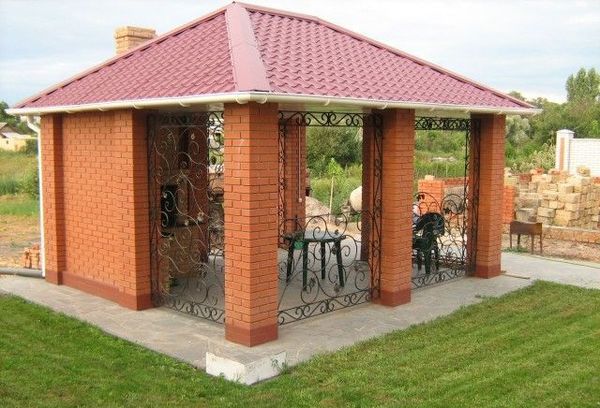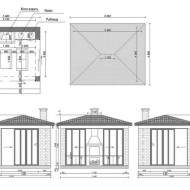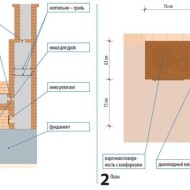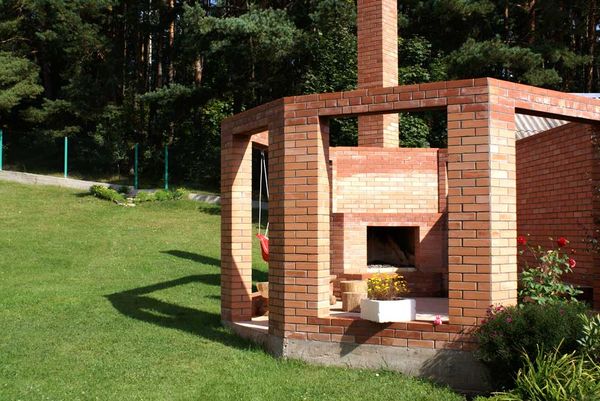How to assemble a brick garden gazebo without building experience
Content
Benefits and features
Building a brick gazebo won't work quickly. Material costs will be many times higher, but the design does not need further special processing and has a number of other advantages:
- durability and appearance that can organically fit into any landscape design;
- reliability - the capital structure perfectly protects against wind, precipitation, dampness and cold;
- the most comfortable and cozy atmosphere;
- ease of care and maintenance;
- you can carry out any communications and place a stove or barbecue.
Brick has a number of characteristics that give the structure a special character compared to structures made of other materials:
- the material does not need additional treatments with antiseptic and refractory materials;
- does not corrode and does not rot, does not swell from moisture;
- not susceptible to the effects of microorganisms and sabotage from rodents;
- easy to use - from the types of bricks offered today and using various masonry methods, you can build a structure of almost any configuration (round, curly, beveled);
- harmoniously combined with other building materials: metal, wood, stone, composite in combination with brick allows you to implement any design projects.
Of the shortcomings, you can only name the time period that will be required for construction, as well as material costs.
Video "DIY brick gazebo"
From this video you will learn how to build a cozy brick gazebo with your own hands.
Views and styles
According to the purpose of the gazebo or the general nature of the landscape design (at the request of the owner), structures of three types are being built: closed, semi-open and open.
Open structures consist of pillars and a roof; they can be supplemented with forged or stone details. Despite the fact that such gazebos are relatively lightweight structures, they still need a foundation. Semi-open structures involve several closed (possibly even blank) walls that can be protected from wind and rain. This option is most popular with a barbecue or built-in oven. Closed gazebos - capital structures, to which all communications can be connected, can serve as a full-fledged living space.
Structures are square, rectangular, round, multifaceted and free in shape. According to the shape, a stove or barbecue and a table with benches or chairs are located inside the gazebo.
The style of the gazebo must be chosen very carefully: it should be an element of the general nature of landscape design or fit into the general idea as much as possible. The most popular styles today are:
- classic - the best option for a strict landscape;
- romantic - suitable for almost any landscape, will create a relaxed atmosphere of lightness and celebration;
- traditional Russian - with the maximum use of wood details;
- eastern - giving the structure an oriental lightness and an atmosphere of calm and relaxation, domed roofs and multi-level;
- modern.
Working technology
The first step is to choose a suitable location. The best option is a spacious place without trees. If a barbecue or stove is planned to be placed in the gazebo, it should be located farther from the house. However, when included in the communications system, proximity to living quarters is necessary.
The selected area needs to be prepared. The first step is to remove all plants that may be placed or other objects. Then you need to apply the markup according to the scheme or project. The markup should display the scheme transferred from the project in real dimensions. For marking, a tape measure and pegs are used, between which a string is stretched to indicate the boundaries of the foundation.
The set of tools will depend on the design features, additional parts, glazing material. Therefore, in addition to construction, you will need tools for working on wood, metal (if the presence of forged elements is assumed), glass cutter, etc.
Foundation
The type of foundation is determined by the type of gazebo: if for a relatively light open structure, you can choose any type - columnar, tape or solid, then for a closed structure only solid is suitable, preferably slab. A solid base is also recommended if a stove or built-in barbecue is expected. For a semi-open type, a solid reinforced foundation with a pit, formwork and a cushion of rubble will be optimal.
The columnar foundation involves the construction of four brick pillars, which go deep into the ground to a depth of 50 cm to 1 m. The base consists of pipes or reinforcement, which are poured with concrete. When installing a solid slab foundation, you can do without a floor device.
Columns
Columns (supports) are located at the corners of the gazebo if the structure is square or rectangular. For columns in heavy brick structures, internal reinforcement is necessarily used. The size of the reinforcement is selected according to the cross-section of the support. The reinforcement inside the support is concreted. An excellent option for the construction of a column is a rack made of a metal pipe or profile, which is buried even before the foundation is poured. Gravel and sand are poured under the counter and concreted at the same time as the foundation is poured. Columns can be made of stone or with wooden elements.
Walls and railings
Beautiful railings that can be built of stone, brick, made of wood or forged elements look very impressive in a wooden building. However, railings are built only in open or semi-open gazebos; closed structures assume the presence of all four brick walls. Walls are usually laid in one brick. The first row is the long side of the brick across the masonry, and the next row is perpendicular to the components of the previous one. Depending on the design, spaces are left in the walls for windows and doors.
Rafters and roofing
The last brick row is the basis for a wooden beam, which is fastened with anchors. The rafters are lined up on the bar. For roofing materials, you will need the construction of a lathing on which slate, tiles, profiled sheets, etc. will be attached. For soft coatings, such as ondulin, moisture-resistant plywood serves as the basis. The hipped roof involves the installation of a polygonal washer, from which the rafter beams will diverge according to the type of sunlight and rely on supports along the perimeter. Crossbars are made between the rafters and only then the roofing material is attached.
Glazing
Small gazebos are almost entirely made of bricks. In large structures, the walls can be up to half or even more glazed. Glazing can assume the presence of frames and frameless structures installed on a metal profile.As a material, you can use ordinary or silicate glass.
Recently, the use of polycarbonate has become popular. Glazing with polycarbonate is easy to do with your own hands.
Finishing options
For finishing the gazebo, both external and internal decoration are used. For exterior decoration, figured masonry (construction element), carved brick, stone, forged and wooden elements, stucco molding, and lamps are used. Inside, you can make a wooden floor and panels, lay it out with tiles or tiles, paste over with wallpaper. There are many options for decor, it is only important not to deviate from the general style.






